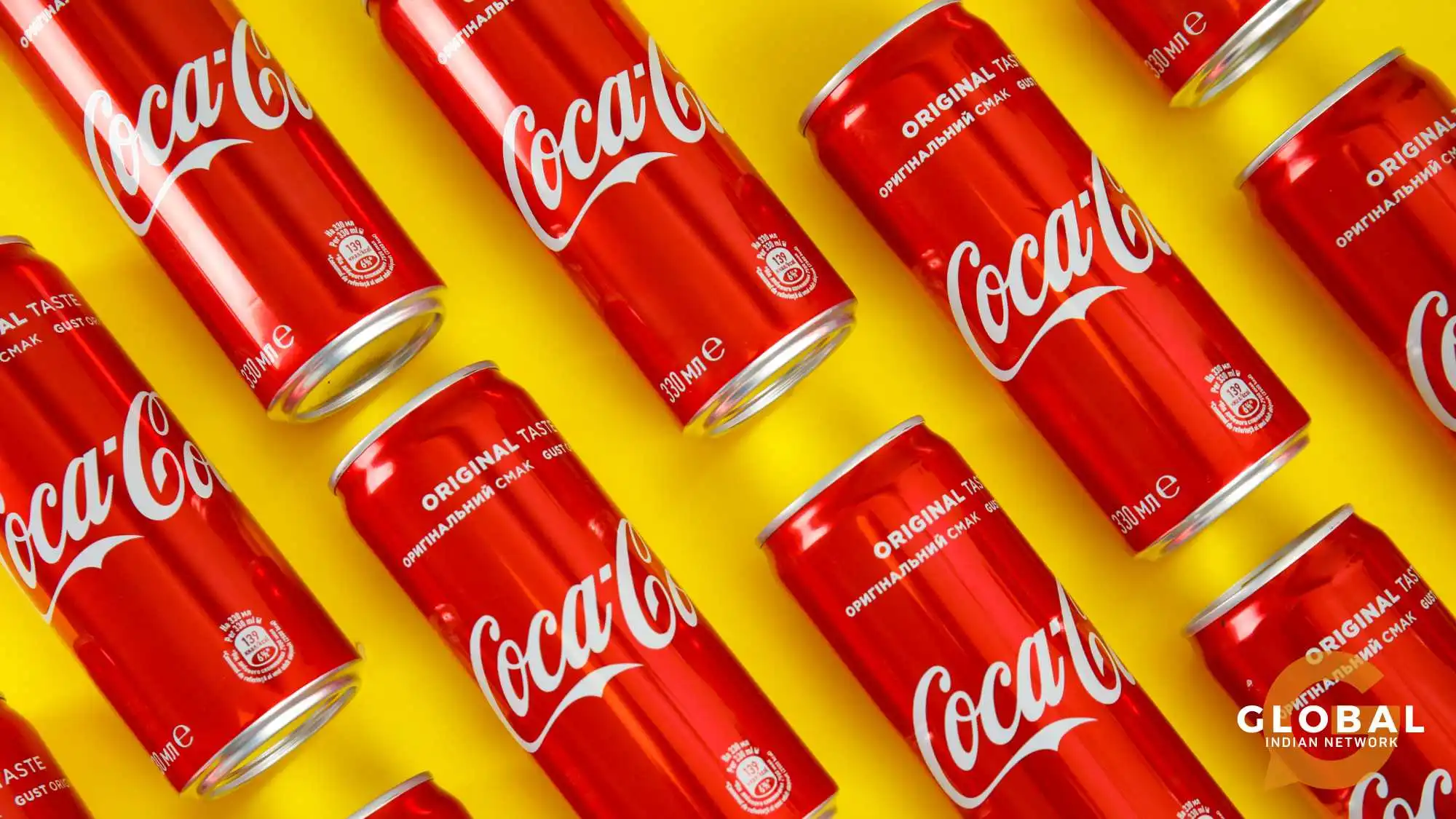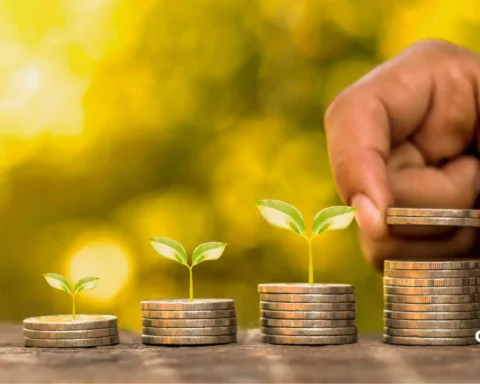Did you know that a vast majority of people in the world happily drink a concoction made of carbonated water, high-fructose corn syrup (or sucrose in some regions), caramel colour, phosphoric acid, natural flavours, and caffeine? We are talking about Coke (or Coca-Cola), which is enjoyed by millions all over the world.
Table of Contents
From the first glass in 1886 to the current 2.2 billion global servings daily (Source: coca-cola company) in 200 countries with 700,000 employees, including partners, Coca-Cola has come a long way. On this journey, they have had their ups and downs. Some of the downs were in the form of protests and accusations against the corporation for over-exploiting water resources to the extent detrimental to people.
The Coca-Cola Company generates revenue by selling concentrates and syrups to authorised bottling partners, who then combine these with water and sweeteners to produce finished beverages. The company also operates company-owned bottling and distribution operations and retail outlets through Costa Limited, including coffee shops, self-serve coffee bars, and ready-to-drink and at-home coffee solutions.
The Coca-Cola system operates through multiple local bottling partners and manufacturing facilities worldwide. In this piece, we deeply dive into the murky waters to determine whether Coca-Cola unfairly deprives you of drinking water.
Ingredients of Coke
Coke contains a relatively short list of ingredients:
- Carbonated water (carbon dioxide solution)
- Sugar (which can be sucrose or high-fructose corn syrup)
- Caffeine (caffeine-free Coke drinks are also available)
- Phosphoric acid vs caramel (E150d - The International Agency for Research on Cancer (IARC) of the World Health Organization has classified 4-MEI as a potential carcinogen. This has raised concerns about the health risks associated with the presence of 4-MEI in E150d, a food colourant. While E150d is considered safe at certain levels, 4-MEI has sparked discussions about the need for regulations and potential alternatives to reduce health risks).
- Natural flavourings, which include coca leaf extract, which is recognised for medicinal purposes under regulations; the de-cocainized leaf is considered safe; cocaine is deemed unsafe and addictive.
Water Required to Make a Half-Litre Bottle of Coke
A half-litre bottle of Coca-Cola requires approximately 22 litres of water when all factors are considered. This includes 15 litres of green water footprint (rainwater stored in the soil as moisture), 1 litre of blue water footprint (surface and ground freshwater used in the production process), and the generation of 12 litres of wastewater. The accurate figures for the one-litre bottle depend on various factors in the production process.
In 2007, the company spokesman stated at the World Wildlife Fund conference in Beijing that the corporation pledges to replace every drop of water used in their beverages and production to attain balance in communities and nature. The concept was to make operations' water neutral' by 2020. The above statement did not include anything about the supply chains on which Coke depended.
Water Footprint
Dutch scientist Arjen Hoekstra created a water-use accounting method called the Water Footprint. This method totals the water used to produce everyday items, including the water needed to grow raw materials and create packaging. Water footprint assessments have highlighted the significant amounts of water required to produce common products, such as a single T-shirt or a quarter-pound hamburger. Countries, corporations, and individuals can calculate their Water Footprints to understand their water usage. For example, the per capita Water Footprint in the United States is 2,060 gallons a day.
The water footprint of Coca-Cola is strongly influenced by local climate, hydrogeology, and topography, which have notable effects on the environment. A comprehensive assessment of the water footprint takes into account the impact of water usage on local watersheds and the sustainability of water sources.
The three Coca-Cola products and ingredients that were assessed for their water footprint are a 0.5 litre PET bottle produced by Coca-Cola Enterprises Inc. (CCE) in the Netherlands, beet sugar supplied to Coca-Cola bottling plants in Europe, and Minute Maid (R) orange juice and Simply Orange (R) produced for the North American market.
This analysis aids in identifying opportunities for sustainable water management and guiding companies and consumers toward more responsible practices. With predictions from the World Health Organization and the United Nations, the context of increasing global water stress emphasises the urgency of sustainable water practices.
Criticisms
Coca-Cola has faced several criticisms over the years. Most of them were based on aspects of water usage and pollution.
Bluewashing
Bluewashing is a term used to describe a company's attempt to appear environmentally responsible while not fully adhering to such principles. Coca-Cola has faced accusations of bluewashing in India due to its claims of water neutrality and positive water balance. Critics argue that these claims do not adequately address the localised impact of Coca-Cola's water extraction, especially in water-stressed areas.
A notable incident occurred in Kaladera, Rajasthan District, where the aquifer's water level significantly dropped after Coca-Cola started operating a bottling plant. This controversy has raised questions about Coca-Cola's commitment to transparent and sustainable water management.
The Coca-Cola plant in Plachimada, Kerala, faced protests and a legal battle due to accusations of environmental harm and water misuse. The conflict ended with the plant's closure in 2004 based on evidence of cadmium and lead due to the production and wastewater generation.
Coca-Cola was criticised for sponsoring the World Water Forum in Mexico due to accusations of water resource abuse in regions like India and Latin America. Critics, including Louise Richards, CEO of War on Want (a charity in the UK that fights poverty), highlighted the contrast between Coca-Cola's public image and its actual impact, including environmental damage, water exploitation, and workers' rights abuses. Richards called for multinational directors' accountability and political recognition of the system's failure to address global poverty.
Acknowledgements and Recommendations
Greenbiz (August 2016): GreenBiz's statement on Coca-Cola's water use highlights the company's dedication to 'replenishing' all the water it uses. Coca-Cola and its bottlers engage in replenishment projects that return water to the sources they use and extend beyond local watersheds. This comprehensive approach reflects a commitment to responsible water stewardship, showcasing Coca-Cola's dedication to sustainability and environmental responsibility and setting a positive example for corporate water management.
(Source: Greenbiz)
Harvard (November 2017): Coca-Cola has acknowledged the importance of addressing water scarcity for its financial success and community welfare. The company focuses on enhancing water efficiency by reducing water usage in manufacturing and shifting attention to its agricultural ingredient supply chain, which accounts for 80% of its total water footprint. This could potentially save over 100 billion litres of water annually. Coca-Cola is also investing in water footprint research, collaborating with water sustainability organisations, and strengthening international partnerships to fortify its supply chain, especially in water-scarce regions like Africa. These water replenishment and efficiency strategies are crucial for Coca-Cola and other global beverage companies.
Environmental Impacts of the Water Footprint of Coke
The ecological implications of the water footprint of Coke pertain to the following:
Bluewater
In 2010, Coca-Cola and The Nature Conservancy released a report on the water footprint of three Coca-Cola products and ingredients during World Water Week. A water footprint measures the total volume of water used directly and indirectly to produce a product. The report found that sugar from sugar beets, Simply Orange, and Minute Maid products have significant water footprints due to agricultural production. These assessments aim to inform strategies for water stewardship and sustainable sourcing.
The report emphasised that operational costs are small compared to other aspects of water usage. Brian Richter, the then director of The Nature Conservancy, stated that even large volumes of water use can be sustainable if the resource is sufficient to support the use and maintain ecological health. The water footprint is not an end but a starting point for addressing the sustainability of the water source.
Green Water
This pertains to rainwater stored as moisture in the ground used to produce crops as ingredients for producing Coke.
As long as the 'gorilla in the room' is discussed and solutions are arrived at, the path to retaining (or replenishing or conserving, whatever the case may be) can lead to sustainable long-term living conditions. Those at the receiving end of this conundrum are people experiencing poverty whose land has been bought and those who have been displaced, in addition to losing access to water resources. Economically, they are too weak to garner any legal action against the bigwigs.
Gray Water
The third category of water use at Coca-Cola has significant implications for the public good. It involves the water needed to mitigate the harmful effects of waste from the coke plant. Approximately 12 litres of water, close to the 15 litres required to produce half a litre of Coke, is highlighted as wastewater. This wastewater could harm the soil, nearby water bodies, marine life, and the surrounding community if not properly treated. Therefore, the company's ethical practices are crucial for the well-being of its neighbourhood.
Sustainability Strategies by Coke
Coca-Cola has devised several steps to be in tune with nature and communities to avoid disrupting their business.
Policy
The Board has assigned oversight of sustainability matters to its committees to benefit from their experience and subject-matter strengths. The Corporate Governance and Sustainability Committee oversees the company's sustainability strategies, initiatives, related risks, and environmental, social, legislative, regulatory, and public policy matters. It evaluates social, political, and environmental trends, oversees sustainability goals and human rights practices, and reviews the public policy agenda and the company's position on significant public policy matters. The Audit Committee oversees specific processes related to external sustainability disclosures and collaborates with the Corporate Governance and Sustainability Committee to oversee sustainability risks. The Talent and Compensation Committee oversees human capital management policies, talent management, leadership, and initiatives promoting diversity, equity, and inclusion (DEI).
Prioritising Operations, Communities, and Watersheds
Coca-Cola has classified its facilities into three categories based on water-related risks and required water efficiency improvements: leadership locations, advanced efficiency locations, and contributing locations. The company's water efficiency goals offer multiple benefits, such as reduced environmental impact, improved community relations, enhanced public image, cost savings, increased sustainability, and regulatory compliance. Coca-Cola uses the World Resources Institute's Aqueduct 3.0 tool and an internal proprietary tool called Facility Water Vulnerability Assessments to measure its water efficiency. The company tracks the water used in its manufacturing processes. It has invested significantly in new technologies and procedures to enhance water efficiency.
World Without Waste
The company launched a new "World Without Waste" initiative to tackle packaging in 2018. Coke described its promise to use 50 per cent recycled content and to recycle "the equivalent" of 100 per cent of packaging by 2030—a bid, the company said, to usher in a "circular economy."
This comprehensive approach of reducing water for production, packaging, and reusing water, including replenishing, aimed to address water consumption in bottling plants, growing ingredients and manufacturing packaging.
The waste initiative hasn't been completely panned. The company's pledge to recycle the equivalent of every bottle and can of its products has been well-received by many in the environmental community. However, despite talk of a "circular economy," the company's new 2030 packaging targets look weak next to those of other Fortune 500 companies. With its plans, Coca-Cola hopes to get halfway there by 2030.
2030 Water Security Strategy Vision
Coke has formulated its water security strategy for 2030, which includes:
- accelerating the actions needed to increase water security.
- sourcing ingredients and touching people's lives (by contributing to sustainable, clean water access that improves livelihoods and well-being while protecting against water-related disasters).
- work to preserve nature and biodiversity and promote advanced water management practices.
(Source: Action on Supply Chain – FAQ - Coca-Cola document)
Pledges
The Coca‑Cola Company understands water is essential for their business, communities, and nature. Hence, they have made some strategic decisions aligned to be achieved by 2030. These include:
- To achieve 100% circular water use—or regenerative water use—across 175 facilities identified as "leadership locations" by 2030.
- Work with partners to help improve the health of 60 watersheds identified as most critical for the company's operations and agricultural supply chains by 2030.
- Aim to return a cumulative total of 2 trillion litres of water to nature and communities globally between 2021-2030.
Coca-Cola's Journey to 2030
Coca-Cola has embraced a sustainability approach and is continuously progressing towards its goal. Some of the steps are:
Improved Water Efficiency
Coca-Cola is committed to ensuring that the water it returns to nature and communities is of good quality. The company's strategy includes sustainable water security, local water replenishment, advocacy for innovative water policies, and responsible water use. Coca-Cola has partnered with organisations like The Nature Conservancy and the World Wildlife Fund to promote water security, improve water quality, and identify its water footprint. Significant investments have been made in new technologies and procedures to reduce water use in its manufacturing process, thereby improving water efficiency and reducing environmental impact.
(Source:harvard.edu)
Good Quality Water Returned to Nature and Communities
Through initiatives and partnerships, Coca-Cola ensures that the water it returns to nature and communities is of good quality. The company's water strategy focuses on sustainable water security, local water replenishment, advocacy for innovative water policies, and responsible water use. The company has also invested in technologies and procedures to reduce water use in its manufacturing process, contributing to improving water quality. These efforts demonstrate the company's commitment to ensuring the water it returns is of good quality.
(Source: globaldata – Coca-Cola Replenishment, 2017-2021, %)
Reduce Water Use in Its Manufacturing
Coca-Cola is committed to sustainability through water recycling in its manufacturing processes and the return of clean wastewater to the environment. The company invests in new technologies to reduce or eliminate water use and conducts studies to understand the impacts of its water use. These efforts have led to reduced water use and improved water efficiency in the manufacturing process. Coca-Cola collaborates with about 200 bottling partners across over 200 countries to achieve these sustainability goals.
Specific Funded Projects for Water Quality
Coca-Cola has funded several projects to improve water quality, including the Replenish Africa Initiative (RAIN), the Coca-Cola Foundation, the Water and Development Alliance (WADA), and the Global Environment and Technology Foundation (GETF). These projects demonstrate Coca-Cola's commitment to improving water quality and access to clean water. The company has set ambitious goals to replenish all the water it uses to make its beverages and has achieved this goal ahead of schedule. Coca-Cola's water stewardship efforts have been recognized, and the company has been working to address biodiversity and climate crises through bold and impactful conservation initiatives.
The company is working with several bodies, including the World Resources Institute (WRI) and The Nature Conservancy, to develop a Water Quality Benefit Accounting (WQBA) methodology to identify shared water quality challenges, activity selection, and recommended water quality indicators and benefit calculation methods.
(Source: Action on Supply Chain – FAQ - Coca-Cola document)
Returned Water to Be Safe for Consumption
Coca-Cola is dedicated to water safety and sustainability. Its water strategy encompasses sustainable water security, local water replenishment, advocacy for smart water policies, and responsible water use. The company has water protection plans in place and recycles water in its manufacturing processes, ensuring the returned wastewater is clean. Partnerships with organisations like The Nature Conservancy help promote water security and improve water quality. The water used in Coca-Cola's manufacturing process is treated and released back into nature at a level that supports aquatic life. The company aims to replenish the water used in its products through community water projects, such as safe water access and reforestation.
Challenges Faced by Coca-Cola
Coca-Cola actively addresses water-related challenges such as scarcity, quality issues, climate change impacts, and local regulations. The company has partnered with organisations like The Nature Conservancy and the Replenish Africa Initiative and invested in new technologies to reduce water use. These initiatives aim to improve water quality and access, reflecting Coca-Cola's commitment to sustainable water management. The company also practices regenerative water use, which involves reducing, reusing, recycling, and replenishing water in local watersheds to benefit other stakeholders and the environment.
(Source: globaldata – Coca-Cola – Water Withdrawal, 2017-2022, Million M3)
Agricultural Water Footprint
Coca-Cola recognises that the production of beverage ingredients accounts for about 92% of its total blue water footprint, which is the volume of surface and groundwater consumed in the production process. The company's water efficiency goals offer multiple benefits, such as reducing environmental impact, enhancing community relations, improving public image, saving costs, increasing sustainability, and ensuring compliance with regulations. These goals contribute to environmental sustainability, strengthen community ties, enhance Coca-Cola's public image, result in cost savings, and help the company adhere to local and international water usage and environmental protection regulations.
(Source: Action on Supply Chain – FAQ - Coca-Cola document)
The Coca-Cola Company and other brand owners have broadened consumer options, including organic products. Honest Tea, Honest Coffee, ViOBiO, and Capri-Sun Bio brands are the organic options they offer within the portfolio in 52 products across the Coca-Cola European Partners (CCEP) territories. These make up 0.3% of the total sales volume.
Cost of Water
Coca-Cola uses a tool to evaluate costs associated with potential water risks and operational costs. In 2022, the Coca-Cola Foundation supported the Valuing Water Finance Initiative by Ceres (a nonprofit organisation dedicated to addressing global sustainability challenges) to encourage investor leadership in water valuation. The analysed projects generated 210 million cubic meters of water benefits. They delivered $39 million in societal value, with an average societal return on investment (SROI) of 3.9. The company's Talent and Compensation Committee approved a water replenishment metric in Leadership Locations, aligning with the 2030 Water Security Strategy. Collaborations with Bluerisk, Valuing Impact, and peer companies aim to understand the societal value created by projects that return water to communities and nature.
Water Stewardship in Concentrate Plants
Water efficiency improvements in its 18 concentrate production plants achieved a 7% average water efficiency improvement across all plants in 2022 compared to a 2015 baseline. The facilities have implemented best practices and governance of water use through "Water Efficiency Maturity Assessments." As an Alliance for Water Stewardship (AWS) member, Coca-Cola is working to certify all 18 of its concentrate production sites against the latest AWS Standard by 2025. (Source: coca-colacompany.com).
(Source: Action on Supply Chain – FAQ - Coca-Cola document)
(Source: Action on Supply Chain – FAQ - Coca-Cola document)
Improving Watershed Health
Coca-Cola has developed a prioritisation framework by overlaying its priority facilities, watersheds, and communities. This framework helps understand risks and develop integrated approaches to enhance water security in its business, operations, and supply chains. The company has long focused on protecting watersheds and acknowledging the unique challenges of global water sources. Watersheds, which supply water for drinking, agriculture, and manufacturing, also provide habitat for flora, fauna, and recreational opportunities. Coca-Cola's 2030 Water Security Strategy emphasises the holistic improvement of watershed health. The company aims to improve the health of 60 critical watersheds for its operations and agricultural supply chains by 2030. (Source: coca-colacompany.com)
Nature-Based Solutions
Recognizing that nature itself often offers the best mechanisms for restoring watershed health, the company, The Coca-Cola Foundation, and our bottling partners invest in nature-based solutions (NBS), such as forest protection and floodplain management, which build on natural processes to manage water systems.
Status As of 2022
To decrease water use in Coke operations, they use internal tools such as the Water Efficiency Catalogue, which assesses technical standards (e.g., on-line flow monitoring, water collection and reuse capabilities) and team culture (e.g., training and communication on the importance of water efficiency) regarding water efficiency in our production facilities and provides innovative best practices (e.g., water reuse for package rinsing and water-free lubrication of conveyor belts).
They are focused on water efficiency improvements in Leadership Locations and Advanced Efficiency Locations that operate in water-stressed contexts, which has resulted in a water use ratio of 1.79 litres of water used per litre of beverage in 2022. The bottling partners have created approximately 300 water replenishment projects, contributing to the vital resource. (Source: coca-cola.com)
Conclusion
Coca-Cola has significantly invested in technologies and procedures to improve water efficiency, leading to reduced environmental impact, improved community relations, and cost savings. The company tracks its water usage and aims to reduce it. Their 2030 challenge focuses on recycling and reusing principles in packaging and collection, with several successful goals announced.
However, there is always room for improvement, as in the case of procuring organic ingredients. As it stands now, it is only 0.3% of sales volume. The remaining 99.7% needs working on. Hence, Coke's responsibility is far from over. Sustainability in half-measures (in this case, much less than half) will not work. The company has to spread the word about incorporating good agricultural practices that will serve many communities as a whole. Indirectly, this will serve societies and nations.
Coca-Cola, being the giant that it is, has the responsibility to follow through with its concept of a 'World Without Waste' for that is what the world needs, not a "World without Water'. Let us hope that it will push through their commitment to sustainability. We hope they have a big enough vision to continue their progress and become a model for other companies to follow.










[…] Coke and Water Sustainability: An Analysis of Corporate Responsibility […]